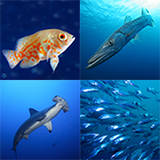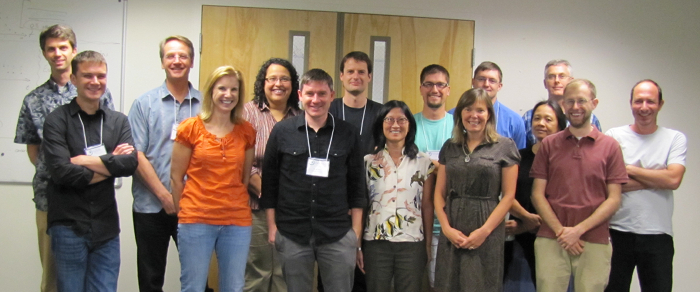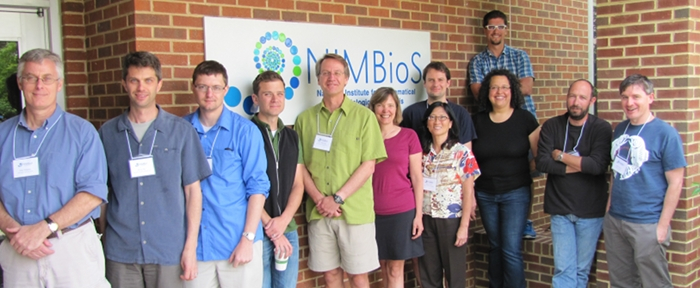| Description | Participants | Summaries | Products |
|---|

Archived NIMBioS Working Group
Suction Feeding Biomechanics
Topic: Integrating biological and mathematical approaches to aquatic suction feeding mechanisms, performance and evolution
Organizers:
Peter Wainwright
(Dept. of Evolution & Ecology, Univ. of California, Davis)
Steven Day
(Dept. of Mechanical Engineering, Rochester Institute of Technology, Rochester, NY)
Meeting dates: September 26-27, 2011; October 29-30, 2012; May 20-21, 2013
Objectives. Suction feeding is the most common mechanism of prey capture in aquatic vertebrates. It is found in ray-finned fishes, aquatic feeding amphibians, turtles, mammals and birds. Unlike terrestrial predator–prey encounters, where predators have no direct effect on the prey’s trajectory during pursuit, aquatic suction feeders exert hydrodynamic forces on prey that are outside their immediate reach. Suction feeders manipulate water flow to draw the prey into the mouth. Vertebrate suction feeding is thus an ideal system for synergistically integrating biology, engineering and mathematics. The variation in morphology and performance within ray-finned fishes and other aquatic-feeding vertebrates provides a rich system for quantitative investigations of functional evolution. The musculoskeletal system responsible for the rapid and powerful expansion of the jaws demanded during suction feeding is mechanically complex and involves many interacting components. Additionally, the flow of water into the mouth is governed by the physics of fluid mechanics, which are non-linear and often non-intuitive. The suction-generated flow-field interacts with the prey to impart complex forces on the prey and can also provide a mechanical stimulus for prey escape responses.
Methods developed within the field of engineering have been successfully applied to biomechanical and biological fluid systems. New understanding of the mechanisms underlying aquatic predator-prey interactions require integrating existing data with improved structural and computational models. There have been significant recent advances in understanding how the musculo-skeletal system of bony fishes moves to generate suction flows, as well as the spatial and temporal pattern of these flows. These advances led to initial modeling efforts of the predator-prey encounter that provided quantitative insights into the nature of suction feeding performance.
This group will synthesize mathematical, mechanical and biological perspectives on these problems (musculoskeletal, fluid mechanical, and prey responses), summarizing existing knowledge and setting an agenda for future research. The overarching goal is the development of comprehensive and accessible predictive mathematical models of prey capture performance based on suction feeding biomechanics that better integrate musculo-skeletal dynamics with predator induced water flows and prey sensory mechanics. These models will allow researchers to quantitatively study the diversity and evolution of suction feeding performance, as well as its morphological, physiological and mechanical basis. We aim to identify how mathematical and numerical models have and can contribute to answering biological questions about suction feeding performance and evolution. Specifically, we will focus on the following questions to provide a roadmap for future work:
- What is the musculo-skeletal basis of suction feeding performance?
- What is the fluid mechanical basis of prey capture during suction feeding?
- What empirical and mathematical needs remain to understand how prey respond to suction?

Meeting Summaries
| Mtg # | Dates | Agenda | Summary | Photo | Evaluation |
|---|---|---|---|---|---|
| 1 | Sep 26-27, 2011 | - | Link | Link | Report |
| 2 | Oct 29-30, 2012 | Link | - | ||
| 3 | May 20-21, 2013 | Link | Link |
Meeting 1 Summary. Suction feeding is the mechanism of prey capture used by almost all aquatic feeding vertebrates, so resolving its complex mechanics is a key to understanding the ecological diversity of suction feeders and the evolutionary history of vertebrate feeding mechanisms. Our group is synthesizing knowledge in three specific areas: the mechanical events that characterize suction feeding both inside the organism and in the surrounding water, the impact of the prey sensory defense system on the success of suction feeding, and the evolutionary history of suction feeding innovations and diversification. We are developing reviews and new primary research aimed at each of these areas. Some of the novel aspects of our work are that we are attempting to unify the mechanical events internal and external to the suction feeder, we will be the first to explicitly consider the mechanism of prey sensory systems in determining the success of suction feeding attempts, and we will incorporate major new discoveries of the relationships among vertebrates into an historical review of how this system has been modified during evolution.
Meeting 2 Summary. Virtually all aquatic-feeding vertebrates use suction feeding as the primary mechanism of prey capture. Therefore, resolving its complex mechanics is critical to understanding the ecological diversity of suction feeders as well as the evolutionary history of vertebrate feeding mechanisms. Our group is synthesizing knowledge in three specific areas: the mechanical events that characterize suction feeding both inside the organism and in the surrounding water, the impact of the prey sensory defense system on the success of suction feeding, and the evolutionary history of suction feeding innovations and diversification. We are synthesizing what is known and incorporating novel research aimed at each of these three areas. A significant aspect of our working group’s efforts are that we are attempting to unify the mathematical basis of the events that occur both internal and external to the suction feeder. We will also be the first to explicitly consider the mechanism of prey sensory systems in determining the success of suction feeding prey capture. Additionally, through a historical review of how this system has been modified during evolution we will synthesize how these events relate to vertebrate macroevolution.
Meeting 3 Summary. TBA
 |
| Mtg. 1 participants (Back row, L to R): S. Day, P. Wainwright, P. Hernandez, S. Van Wassenberg, T. Higham, T. Skorczewski, A. Cheer, G. Burgreen, R. Holzman. (Front row, L to R): M. McHenry, L. Ferry, D. Hulsey, J. Yen, A. Gibb, D. Murphy. |
 |
| Mtg. 3 participants (L to R): Greg Burgreen, Steven Day, Tyler Skorczewski, Matt McHenry, Peter Wainwright, Alice Gibb, Jeannette Yen, Sam Van Wassenbergh, Patricia Hernandez, Tim Highman, Roi Holzman, Darrin Hulsey |
NIMBioS Working Groups are chosen to focus on major scientific questions at the interface between biology and mathematics. NIMBioS is particularly interested in questions that integrate diverse fields, require synthesis at multiple scales, and/or make use of or require development of new mathematical/computational approaches. NIMBioS Working Groups are relatively small (up to 10 participants), focus on a well-defined topic, and have well-defined goals and metrics of success. Working Groups will meet up to 3 times over a two-year period, with each meeting lasting up to 2.5 days.
A goal of NIMBioS is to enhance the cadre of researchers capable of interdisciplinary efforts across mathematics and biology. As part of this goal, NIMBioS is committed to promoting diversity in all its activities. Diversity is considered in all its aspects, social and scientific, including gender, ethnicity, scientific field, career stage, geography and type of home institution. Questions regarding diversity issues should be directed to diversity@nimbios.org. You can read more about our Diversity Plan on our NIMBioS Policies web page. The NIMBioS building is fully handicapped accessible.
NIMBioS
1122 Volunteer Blvd., Suite 106
University of Tennessee
Knoxville,
TN 37996-3410
PH: (865) 974-9334
FAX: (865) 974-9461
Contact NIMBioS


